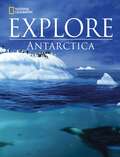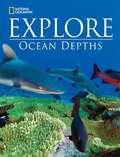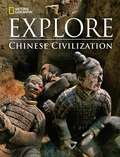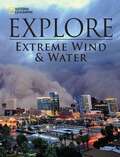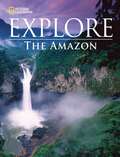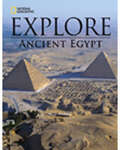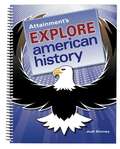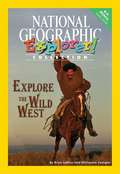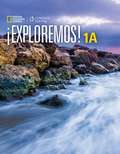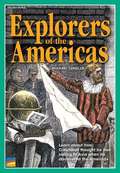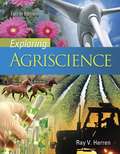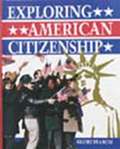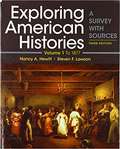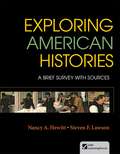- Table View
- List View
Explore: Antarctica (National Geographic Explore Series)
by National Geographic LearningNIMAC-sourced textbook
Explore: Chinese Civilization (National Geographic Explore Series)
by National Geographic LearningNIMAC-sourced textbook
Explore American History
by Judi KinneyThe Student Book has 9 chronological chapters from Early Years to A New Century. These follow a consistent format: Anticipatory Set, Vocabulary, History Stories, and Quiz. Twenty-five one-page biographies with corresponding comprehension exercises are also aligned to the curriculum's chronology.
Explore Our Land
by Sarah Bednarz Catherine Clinton Michael Hartoonian Arthur Hernandez Patricia L. Marshall Pat NickellLearning about geography can help you answer many questions about the regions of our land, the United States.
Explore Our Land
by Sarah Bednarz Catherine Clinton Michael Hartoonian Arthur Hernandez Patricia L. Marshall Pat NickellExplorer T.H. Culhane: Energy Solutions (Science 4 #Book Five)
by Phelan Glen Culhane T. H. Winegar LaraNIMAC-sourced textbook
Explorer Zoltan Takacs: Snake Venom (Science 6 #Book One)
by National Geographic LearningNIMAC-sourced textbook
Explorers of the Americas
by Michael Sandler Margaret McnamaraPerform this script about an ancient Maya love story. (Set of 12 with Teacher's Guide)
Explorers on the Move (Fountas & Pinnell Classroom, Guided Reading)
by Stephen Krensky Pete SmithNIMAC-sourced textbook. Fearless Frank and Hotfoot Harry are brave explorers traveling through dangerous places. Or are they two boys going home for a hot lunch?
Exploring America, Part 1 (Columbus to Reconstruction)
by Ray NotgrassThis curriculum will guide you through the story of our country from the first European explorers to the present. We place great emphasis on original documents and speeches because these allow the participants in history to tell the story from their own perspective. This curriculum also introduces some of the great literature that Americans have produced: novels, short stories, autobiographies, memoirs, essays, poems, hymns, and other kinds of writing. The written and spoken word has a profound ability to move hearts and minds. This course also explores the significance of faith with regard to history. Faith is connected with history in two ways. First, people have often been motivated to act because of their faith in God. For instance, faith motivated the Pilgrims on the Mayflower to seek a new land in which to live. Faith caused people to oppose slavery. Faith has been expressed often in the speeches and documents that Americans have produced. We recognize and highlight the importance of faith throughout the American story. A second way that faith should be connected to history is by looking at the overall story of American history through the eyes of faith. We encourage students to think about the faith lessons that they can learn from people and events in history. For instance, many God-fearing Americans owned slaves and had a strong prejudice against blacks. We need to understand what caused those Christian people to be blinded by their culture and how they missed the example of Jesus and the teaching of Scripture about this issue (see John 4:7-9, Galatians 3:28, and Ephesians 2:19). This might help us realize cultural blindnesses we suffer today. A study of history can inform, challenge, and strengthen our own faith. "
Exploring America, Part 2 (Late 1800's to Present)
by Ray NotgrassThis curriculum will guide you through the story of our country from the first European explorers to the present. We place great emphasis on original documents and speeches because these allow the participants in history to tell the story from their own perspective. This curriculum also introduces some of the great literature that Americans have produced: novels, short stories, autobiographies, memoirs, essays, poems, hymns, and other kinds of writing. The written and spoken word has a profound ability to move hearts and minds. This course also explores the significance of faith with regard to history. Faith is connected with history in two ways. First, people have often been motivated to act because of their faith in God. For instance, faith motivated the Pilgrims on the Mayflower to seek a new land in which to live. Faith caused people to oppose slavery. Faith has been expressed often in the speeches and documents that Americans have produced. We recognize and highlight the importance of faith throughout the American story. A second way that faith should be connected to history is by looking at the overall story of American history through the eyes of faith. We encourage students to think about the faith lessons that they can learn from people and events in history. For instance, many God-fearing Americans owned slaves and had a strong prejudice against blacks. We need to understand what caused those Christian people to be blinded by their culture and how they missed the example of Jesus and the teaching of Scripture about this issue (see John 4:7-9, Galatians 3:28, and Ephesians 2:19). This might help us realize cultural blindnesses we suffer today. A study of history can inform, challenge, and strengthen our own faith. "
Exploring American Citizenship
by Globe FearonThe Student Texts and Student Workbooks provide helpful charts, tables, and maps that allow students to look closely at all critical aspects of U.S. government, including citizenship, the justice system, foreign policy, and much more. The book helps students understand the development of the government and the rights and laws of local, state, and federal governments.
Exploring American Histories: A Survey with Sources (American Histories #1)
by Nancy A. Hewitt Steven F. LawsonOur book offers a new kind of U.S. history survey text, one that makes a broad and diverse American history accessible to a new generation of students and instructors interested in a more engaged learning and teaching style. To accomplish this, we carefully weave an unprecedented number of written and visual primary sources, representing a rich assortment of American perspectives, into each chapter.
Exploring American Histories: A Brief Survey with Sources
by Nancy A. Hewitt Steven F. LawsonThis book written in an innovative format makes broad and diverse American history accessible to students and instructors interested in a more active learning and teaching style.
Exploring American History
by John O'ConnorIn this book you will read the story of your country from its beginnings to the present day. The people who tell this story are called historians. You may wonder how historians find out what happened in the past. Historians are like detectives. They use many kinds of clues to learn about the way people lived and what they did in years gone by.
